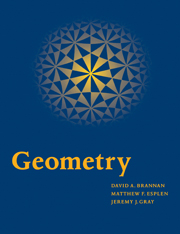Book contents
- Frontmatter
- Contents
- preface
- Introduction: Geometry and Geometries
- 1 Conics
- 2 Affine Geometry
- 3 Projective Geometry: Lines
- 4 Projective Geometry: conics
- 5 Inversive Geometry
- 6 Non-Euclidean Geometry
- 7 Spherical Geometry
- 8 The Kleinian View of Geometry
- Appendix 1 A Primer of Group Theory
- Appendix 2 A Primer of Vectors and Vector Spaces
- Appendix 3 Solutions to the Problems
- Index
7 - Spherical Geometry
Published online by Cambridge University Press: 05 June 2012
- Frontmatter
- Contents
- preface
- Introduction: Geometry and Geometries
- 1 Conics
- 2 Affine Geometry
- 3 Projective Geometry: Lines
- 4 Projective Geometry: conics
- 5 Inversive Geometry
- 6 Non-Euclidean Geometry
- 7 Spherical Geometry
- 8 The Kleinian View of Geometry
- Appendix 1 A Primer of Group Theory
- Appendix 2 A Primer of Vectors and Vector Spaces
- Appendix 3 Solutions to the Problems
- Index
Summary
In this chapter we study the geometry of the sphere, which might be considered a more plausible idealization of the Earth we live on than the Flat Earth of Euclidean plane geometry. The simplest curves to study are the curves of shortest length (that is, the geodesies) on the sphere; these are arcs of circles of unit radius on the sphere, with their centres at the centre of the sphere. These are the closest analogues of straight lines in plane geometry. The group of transformations we shall study is the group of isometries of the sphere. Clearly a rotation of the sphere is an isometry, and we shall see that the group of isometries is composed of rotations of the sphere together with reflections in great circles. It turns out that any orientation-preserving isometry of the sphere is in fact a single rotation.
We usually take the sphere to have radius 1.
Recall that an isometry is a one–one mapping that preserves distances.
We first establish a system of coordinates for the sphere; these are essentially the familiar coordinates of latitude and longitude. Then we obtain matrix representations for the isometries of the sphere: every isometry can be written as a 3×3 matrix. Then we define a triangle on the sphere, find a formula expressing its area in terms of the sum of its angles, and show that every spherical triangle has two congruent dual triangles.
- Type
- Chapter
- Information
- Geometry , pp. 327 - 359Publisher: Cambridge University PressPrint publication year: 1999



